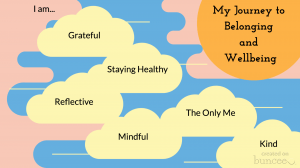One of the major things I missed as an administrator was teaching a classroom filled with students. Even more than being physically present with students, I miss planning and innovating in my lessons. Over the past few years, I’ve learned a number of apps and educational technologies that I wished existed when I was teaching years ago. Tools like Flipgrid, Buncee, Wakelet, Book Creator, Microsoft Teams, Google for Education, Canva, and Adobe Spark have challenged my learning and enhanced my ability to communicate my message about belonging, inclusion, equity, compassion, and supporting refugees. And lately, I have seen the amazing things teachers are creating for their students to ensure learning continues even as we face so much disruption and uncertainty. Talk about being FOMO!
There are two apps I am now creating with and have decided to jump back into creating lessons. The apps, Adobe Spark and Buncee are fun to use and extremely versatile, AND there are educators involved in the creation of new features and templates all the time which makes them so up to date and user friendly. I’m sure there are many other creative apps that are versatile and easy to use for students and teachers, but I’m most familiar with these two and I can get lost for hours creating and sharing. I’ll start with my Buncee journey first.
About a year ago, I gently dipped my toes into the Buncee waters. Initially, the water felt a bit cool since I wasn’t using it very often, so it seemed a bit daunting to figure out. But then I heard about the Buncee Summer Challenge and decided to join in the daily activities. I could choose when and which ones I wanted to complete and then share them on social media I started figuring out the different and multiple ways I could fulfill each challenge and when I shared my finished Buncee, the reaction from the community and from Buncee was so gratifying! One day the challenge was to use the draw feature in the app to create a “copy” of famous artworks. I thought to myself, I feel intimidated by drawing, so how do I feel about drawing and sharing it with people I don’t know? Well, as you can see from the finished product, I didn’t do too badly. And the best part was I had fun while I did it! How amazing is that from someone who has always suffered from a lack of confidence in my ability to draw anything?
But then I realized I wanted to share my expertise in Belonging with teachers since many are wondering how to build safe spaces and relationships in a virtual space or mask to mask in the classroom (and 6 feet apart). So I created a Buncee lesson about how to become a Good Ancestor which is posted in Ideaslab: https://app.edu.buncee.com/buncee/9a0d4c4f25784f74a03b9cdda5f91691

“Treat the world well. It was not given to you by your parents. It was willed to you by your children.” Kenya proverb
I have also used Buncee templates to create activities related to “My Journey to Belonging and Wellbeing”. I am also working on a lesson plan to go along with the activities. https://app.edu.buncee.com/buncee/13d2f34486a84f8791406a26a54025e5
Lately, after a competition announced by Wakelet and Adobe Spark, I found even more creativity that I could use to amplify my voice and the voice of the refugee leaders I support in Kakuma (who are now using Adobe Spark). The competitive challenges and supporting training videos by Dom Traynor really helped me understand the amazing ways I can use it to tell stories and market ideas. Then I found out about the Adobe Creative Educator training track with badges and 1-3 hour courses. I started with a Storytelling course and then followed with the Level 1 ACE course. Once I uploaded the assignments, I felt so accomplished!
The Level 2 course was recently released on https://edex.adobe.com and I couldn’t wait to start. Once lessons are completed, there are two assignments to complete. The first is a lesson plan using Adobe Spark and Assignment 2 is creating a video with Spark. There are examples and templates which is really helpful and a variety of educators present videos throughout the 3-hour course. I wasn’t sure I’d be able to complete the lesson plan since I’ve been out of the classroom for seven years, but I decided to try anyway. Once I saw the exemplar, I knew I could do it! There are so many lessons I used when I was a third-grade teacher before the age of apps and edtech. This would be my chance to upskill my lesson and show how to incorporate creativity. I remember having my students create a school newspaper and how much they enjoyed choosing the section they would contribute to and create the final product. Here’s the lesson I created which can suit ELA standards and language objectives in almost all grades 3-12, and with a bit of support, even scaffolded or scaled down for KG – 2.
I’m so excited to be back into the lesson planning mindset and am looking forward to creating plans for the book I am writing about belonging. I’d love feedback about the lessons and activities I’ve shared here.




